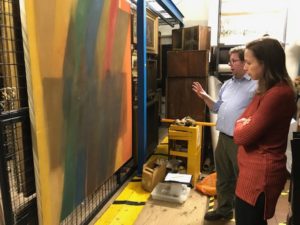
Albert Irvin painting being examined by Art Conservator
In May 2019 I was invited to give a talk to the Friends of Blackburn Museum and Art Gallery. I decided to tell them all about a project I had been working on, to rediscover Fine Art that had been acquired via the Contemporary Art Society. The following article summarises my research and project underway to conserve, remount and reframe some of the pieces of art.
Early in 2019 the Contemporary Art Society contacted the museum as they were updating their records of historic gifts to regional art galleries. I was asked to confirm past acquisitions in the permanent collection at Blackburn Museum and Art Gallery.
The Contemporary Art Society is a charity that purchases important works of art to place in public collections across the UK. It exists to encourage an appreciation and understanding of contemporary art, and since 1910 it has donated over 8000 works to museums and public galleries. It champions new talent and supports curators, encouraging philanthropy and collecting in the UK. Looking through some records, Blackburn Museum and Art Gallery seem to have been members of the Contemporary Art Society during the 1950s, 1960s and 1970s, when it was accepting gifts from them in return for a membership fee. http://www.contemporaryartsociety.org/
To set the scene, the late 1950s saw a period of modernisation for the library service with Clement Attlee opening the modernised library in April 1959. Even so, the topic of the library not being big enough to accommodate the service was ever under discussion and eventually the library split from the museum in the 1970s. To speculate, perhaps around this time membership in the Contemporary Art Society became less of a priority and our acquisitions through this source dried up.
My task was to aid the Contemporary Art Society in updating their records. The list given by the Contemporary Art Society hosts a list of names of high quality and internationally important 20th century British artists. The following details just a few of these artists represented in the permanent collection in Blackburn Museum and Art Gallery.
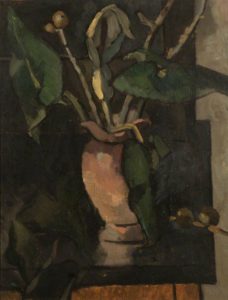
Coldstream, William Menzies; Lords and Ladies; Blackburn Museum and Art Gallery; http://www.artuk.org/artworks/lords-and-ladies-153745
Sir William Menzies Coldstream (1908 – 1987)
Starting with one of the oil paintings, this one is by William Coldstream. The painting is called Lords and Ladies and was gifted to us in July 1954. Coldstream was born in Belford, Northumberland on 28 February 1908 and grew up in north London. He studied at the Slade School of Fine Art 1926-9. In 1931 he joined the London Artists’ Association and then, two years later, the London Group. In 1934, Coldstream joined the General Post Office Film Unit, writing and directing films, painting at the weekends and in his spare time. In 1937 he joined his friends Claude Rogers and Victor Pasmore in establishing a new School of Drawing and painting in Fitzroy Street, the school later moved to the Euston Road. The school promoted art in realist tradition that would be more readily accessible and understandable to a wider public.
During the Second World War, Coldstream was appointed an Official War Artist in the Middle East and Italy. In Egypt he had a studio close to the Pyramids and spent most of his time painting portraits of Indian soldiers. After being de-mobbed he took on a teaching job at Camberwell School of Art, where he was later appointed Head of Painting. His sense of public duty led to appointments as a Trustee of the Tate, Chair of the Art Panel of the Arts Council, a Director of the Royal Opera House and Chair of the British Film Institute. He was knighted in 1956.
I have alluded to the fact I have concerns about the condition of this area of the collection, and as I had begun an audit and review of all acquisitions from the CAS, I thought it was worth getting a good overview of the condition of the collection. I invited Philip Bourne, the painting conservator from the Lancashire County Council Conservation Studio in Preston.
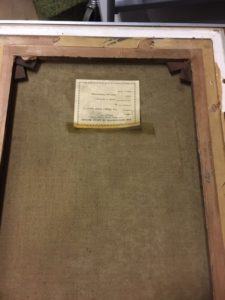
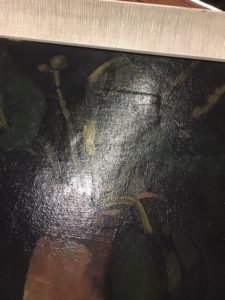
In the case of Lords and Ladies, I assumed there were no issues as the paint was stable however Philip was able to identify what now seems obvious. On the reverse of the canvas, sellotaped directly onto the canvas is an old label and Philip picked up on this straight away. He pointed out that anything stuck to the back of a canvas can leave its mark on the front paint/image. Turning it over it then became clear this had happened. In this photo you can just make out a raised area where the label is stuck. The label has altered the shape of the canvas in this area. Although this effect cannot be reversed, the label can be removed safely to prevent any further damage.
Albert Irvin (1922 – 2015)
Another oil painting in the collection is Rider, dated 1969 by Albert Irvin. Albert Irvin was an English expressionist abstract artist born in London in August 1922. He was evacuated during World War II, to study at the Northampton School of Art between 1940 and 1941, before being conscripted into the Royal Air Force as a navigator. When the war was over, he resumed his course at Goldsmiths College from 1946 to 1950, where he would later go on to teach. He was elected to The London Group in 1955 and worked in studios in the East End of London from 1970 onwards.
In the early 1950’s Bert met and was hugely influenced by many of the “St Ives” artists – Peter Lanyon, Roger Hilton, Terry Frost, Sandra Blow amongst others. His work was widely exhibited both in the UK and abroad, in such places as Arts Council of Great Britain, Birmingham City Art Gallery, the Chase Manhattan Bank, the Contemporary Art Society, Manchester City Art Gallery, Tate Britain, the Victoria and Albert Museum and Warwick University Arts Centre. His influences included Walter Sickert, Henri Matisse, JMW Turner, Jack Smith and Edward Middleditch. Irvin was given an OBE in the 2013 Birthday Honours for services to the visual arts. He died just a few years ago in 2015.
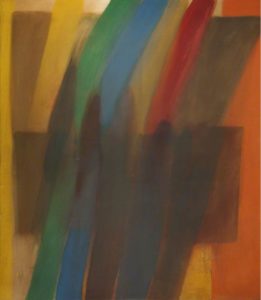
Irvin, Albert; Rider; Blackburn Museum and Art Gallery; http://www.artuk.org/artworks/rider-153858
This painting is large and impressive. After some consultation with Philip, it was established the canvas was not very securely fixed to the frame and he recommended it be fixed more securely and have a frame made for it.
In addition to oil paintings are 11 works on paper gifted to Blackburn Museum by the Contemporary Art Society. This pen and wash is by Josef Herman entitled, Three women with sheaves of corn, gifted to us in May 1962.
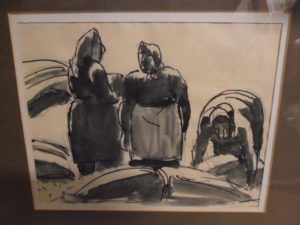
Josef Herman (1911 – 2000)
Josef Herman was a highly regarded Polish-British realist painter who influenced contemporary art, particularly in the United Kingdom. His work often depicted workers as it subject and was inherently political. He was among more than a generation of eastern European Jewish artists who emigrated to escape persecution and worked abroad. For eleven years he lived in South Wales.
For the works on paper, Philip Bourne on his visit to Blackburn Museum gave an assessment of the mounts and identified for a number of the pieces of art that the mounts were potentially highly acidic and either has or will cause damage to the art works in the future. For example, for the work called Gathering Groundnuts, by Dennis Mathews, Philip identified the back as strawboard, which is very fibrous in nature, very acidic and self-destructs over time. The pieces of art trapped in such mounting and framing I think need to be rescued and re-framed.
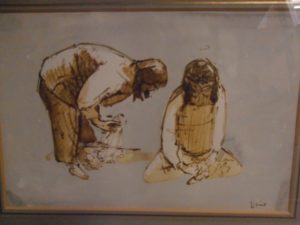
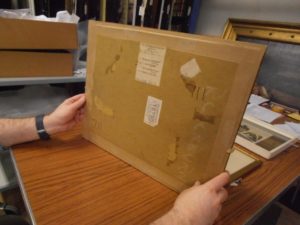
There are some issues affecting the acquisitions from the Contemporary Art Society. The large Irvin canvas needs framing, the Coldstream label on the reverse needs to be removed safely and the works on paper are inadequately mounted, encased in highly acidic environments. The group of artworks are now in the care of the Conservator Philip Bourne and are due to return to Blackburn Museum and Art Gallery for display in a temporary exhibition in September 2020, so watch this space.
This exhibition might surprise visitors by showcasing an array of 20th century artists, where the majority of paintings on display age from the Victorian or Edwardian periods. We welcome local art students and school pupils to come and be inspired by the newly conserved and framed works of art and also hope that members of the Contemporary Art Society might come and find out how the society has had an impact on the contemporary collecting of this gallery.